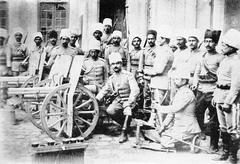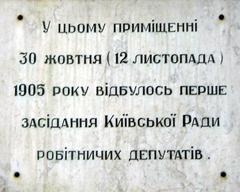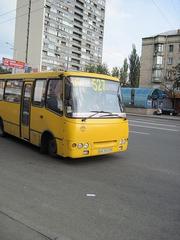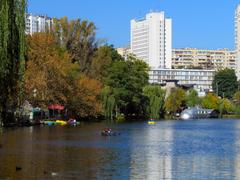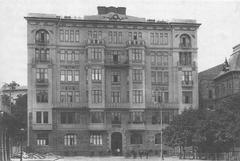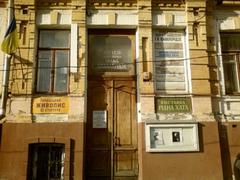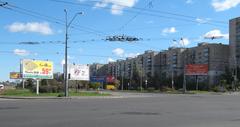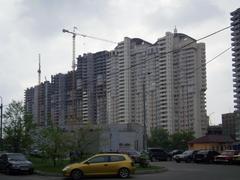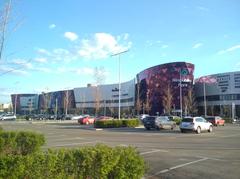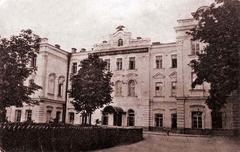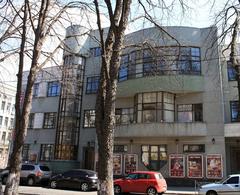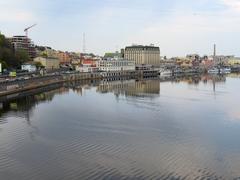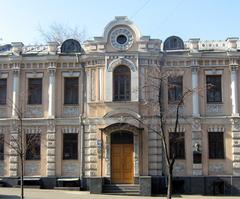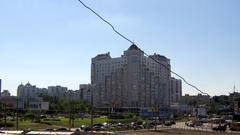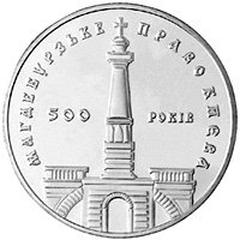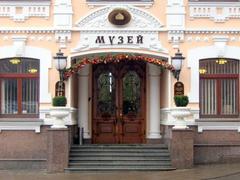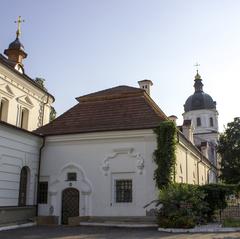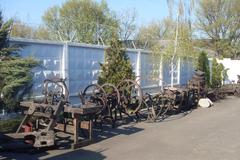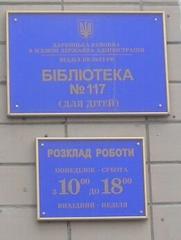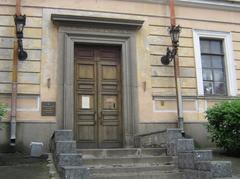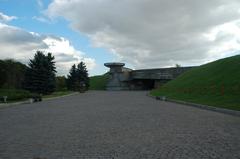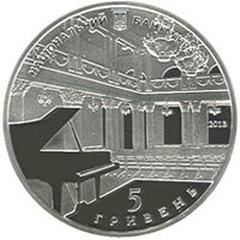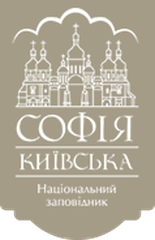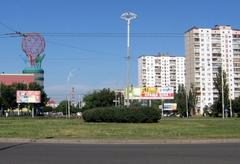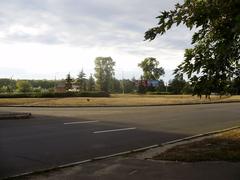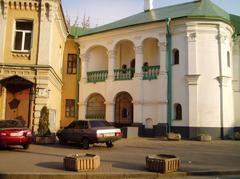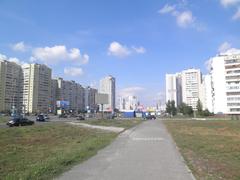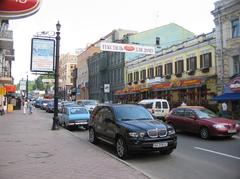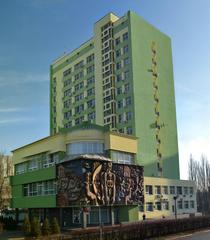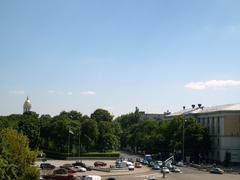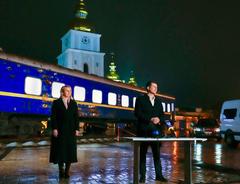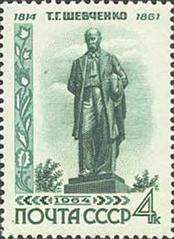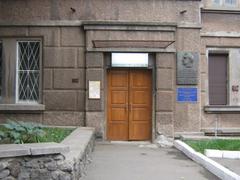Serpova Street Kyiv: Visiting Hours, Tickets, and Historical Sites Guide
Date: 04/07/2025
Introduction
Serpova Street, set within Kyiv’s Sviatoshynskyi and Podil districts, offers an immersive portal into the capital’s living history. Unlike Kyiv’s most frequented tourist hotspots, Serpova Street provides visitors with an authentic glimpse of the city’s everyday rhythms, layered urban evolution, and vibrant contemporary life. This comprehensive guide explores the street’s historical context, architectural features, cultural significance, practical visitor information, and tips for experiencing its unique charms and nearby attractions.
Table of Contents
- Introduction
- Early Development and Historical Context
- Soviet Era and Urban Transformation
- Post-Soviet Evolution and Modern Significance
- Architectural and Cultural Features
- Cultural Significance and Community Life
- Visitor Information
- Parks, Green Spaces, and Urban Relaxation
- Nightlife and Evening Activities
- Practical Visitor Tips
- Preservation and UNESCO Considerations
- Historical Layers and Local Identity
- FAQ
- Conclusion and Call to Action
- References
Early Development and Historical Context
Serpova Street traces its roots to Kyiv’s rapid urban growth in the late 19th and early 20th centuries. Named after the Ukrainian word for “sickle,” it symbolizes the Soviet-era drive for industrialization and ideological reshaping of the city after the Ukrainian SSR’s capital was moved to Kyiv in 1934 (History of Kyiv). The area’s grid-like street plan and utilitarian architecture are a direct legacy of this period, contrasting with the medieval lanes of central Podil.
Soviet Era and Urban Transformation
During the 1930s–1970s, Serpova Street developed as a residential zone for workers and their families. The street is characterized by Khrushchyovka apartment blocks—simple, functional, and built to address housing shortages (OpenAlfa: Serpova Street). Community amenities like schools and clinics were integrated into the urban design, many of which still serve local residents today.
Post-Soviet Evolution and Modern Significance
After Ukraine’s independence in 1991, Serpova Street and its surroundings experienced significant revitalization. Soviet-era buildings have been renovated, and the area now houses a vibrant mix of businesses, creative spaces, and educational institutions. This transformation reflects Kyiv’s broader journey from a centrally planned city to a diverse, market-driven metropolis.
Architectural and Cultural Features
Byzantine and Baroque Influences
Though Serpova Street itself is mostly Soviet-era in character, its proximity to the Podil district and central Kyiv means that visitors can admire Byzantine, Baroque, and Neo-Byzantine architectural motifs in nearby buildings. Notable influences include gilded domes, decorative stucco, and colorful facades reminiscent of Saint Sophia’s Cathedral and St. Andrew’s Church (EAA: 10 Best Architectural Buildings in Kyyiv).
19th-Century Urbanism and Neo-Byzantine Revival
The 19th century saw a surge in urban development, with new merchant houses and residential buildings featuring Neo-Byzantine and Neo-Renaissance designs—arched windows and ornate brickwork that signaled Kyiv’s growing prosperity (Gateway Travel).
Soviet-Era Transformations
Serpova Street’s Khrushchyovka blocks and public institutions are emblematic of Soviet modernist architecture—prioritizing function and accessibility over ornamentation (Matador Network).
Contemporary Revitalization
Recent years have brought street art, creative studios, and pedestrian-friendly upgrades. Many former warehouses now serve as galleries, cafés, and artisan workshops, blending the street’s industrial past with a modern, creative spirit (CUUB Studio).
Cultural Significance and Community Life
Artistic and Literary Heritage
Serpova Street has become a hub for Kyiv’s creative communities. Galleries, workshops, and bookstores host exhibitions, readings, and workshops, contributing to a lively, intellectual atmosphere (Kyiv City Guide).
Religious and Spiritual Life
Nearby churches and synagogues reflect Kyiv’s religious diversity and serve as both community centers and architectural highlights (EAA: 10 Best Architectural Buildings in Kyyiv).
Markets, Cafés, and Everyday Culture
The street and its surroundings are home to bustling markets, artisan boutiques, and a wide range of cafés and restaurants—from traditional Ukrainian bistros to vegan-friendly spots (KAYAK Kyiv Guide; CultureActivities.com).
Visitor Information
Visiting Hours and Access
Serpova Street is a public thoroughfare and open 24/7, year-round. Shops, galleries, and cafés typically operate from 10:00 AM to 8:00 PM. Always check individual venues for specific hours.
Tickets and Admission
No ticket is required to explore Serpova Street. Some museums, galleries, or events may charge an admission fee—refer to each venue’s website for details.
Getting There and Transportation
- Metro: The nearest stations are Kontraktova Ploshcha and Poshtova Ploshcha on the Blue Line (M2), about a 10-minute walk (Tourist Places Guide).
- Bus/Tram: Multiple lines serve Podil and Serpova Street.
- From Boryspil Airport: Use the Sky Bus to Kyiv’s central railway station, then transfer to the metro.
- Taxis & Ride-Sharing: Apps like Uber and Bolt provide fixed rates and reliability (Xplrverse).
Accessibility
Serpova Street is pedestrian-friendly, with even paving and clear signage. Some historic buildings have limited accessibility, but most public spaces and modern venues accommodate strollers and wheelchairs.
Guided Tours and Events
Local operators offer walking tours that include Serpova Street and nearby Podil landmarks, focusing on architecture, street art, and culinary experiences. Book in advance for peak seasons (PG World).
Amenities and Nearby Attractions
- Parks & Green Spaces: Landscaped courtyards and pocket parks provide places to relax. Larger parks along the Dnipro River are nearby.
- Dining: Podil boasts a thriving food scene—traditional, contemporary, and vegetarian options abound (Freetour.com).
- Shopping: Artisan boutiques and seasonal markets offer local crafts, textiles, and vintage finds.
Parks, Green Spaces, and Urban Relaxation
Despite its urban setting, Serpova Street has access to tranquil courtyards, landscaped gardens, and is within walking distance of the Dnipro riverside parks—perfect for picnics, photography, and peaceful strolls (CultureActivities.com).
Nightlife and Evening Activities
As night falls, Serpova Street’s cafés, wine bars, and music venues come alive with live performances, DJ sets, and themed events—making the area a hotspot for Kyiv’s creative and social scene.
Practical Visitor Tips
- When to Visit: Late spring (May–June) and early autumn (September–October) offer the best weather and lively street scenes.
- Safety: Kyiv is generally safe; remain aware of your belongings in crowded markets.
- Language: Ukrainian is official, Russian is widely understood, and English is spoken in tourist areas.
- Payments: Both cash (UAH) and cards are widely accepted.
- Water: Drink bottled water, as tap water is not recommended.
- Tipping: Standard is 10–15% in restaurants.
Preservation and UNESCO Considerations
Kyiv’s historic center, including Serpova Street, is under active preservation. In 2025, the Ministry of Culture announced plans to seek enhanced UNESCO protection to safeguard the area’s unique architectural and cultural heritage (Ukrinform).
Historical Layers and Local Identity
Serpova Street’s evolution from a Soviet-era residential zone to a vibrant, creative neighborhood mirrors Kyiv’s resilience and adaptability. Its blend of utilitarian and decorative architecture, lively markets, and emerging arts scene encapsulate the district’s enduring spirit (OpenAlfa: Serpova Street).
FAQ
Q: What are Serpova Street’s visiting hours?
A: It is a public street, accessible 24/7. Venues typically open from 10:00 AM to 8:00 PM.
Q: Are tickets required to visit Serpova Street?
A: No ticket is needed to explore the street; some attractions may charge admission.
Q: How do I reach Serpova Street from Boryspil Airport?
A: Take the Sky Bus to the central station, then the metro (Blue Line) to Kontraktova Ploshcha.
Q: Are guided tours available?
A: Yes, local operators offer both group and private walking tours covering Serpova Street and Podil.
Q: Is the area safe?
A: Podil and Serpova Street are considered safe; exercise standard precautions.
Conclusion and Call to Action
Serpova Street stands as a vibrant testament to Kyiv’s past and present—inviting travelers to discover its architectural gems, creative spirit, and authentic urban life. Accessible, walkable, and filled with local color, it is perfect for those seeking to experience Kyiv beyond the postcard landmarks.
To enrich your journey, download the Audiala app for curated walking tours, interactive maps, and real-time event updates. Follow Kyiv’s official tourism channels and our social media pages for insider insights and the latest cultural highlights. Embrace the charm of Serpova Street and uncover the true soul of Kyiv’s historic neighborhoods.
References
- History of Kyiv (Wikipedia)
- Exploring Serpova Street: A Historical and Cultural Guide to Kyiv’s Sviatoshynskyi District (OpenAlfa)
- The Fascinating History of Kyiv, Ukraine (World City History)
- 10 Best Architectural Buildings in Kyyiv (EAA)
- Interesting Places in Kyiv: 10 Places Worth Visiting (Visit Ukraine)
- Exploring Serpova Street: Visiting Hours, Attractions, and Kyiv Historical Sites (CultureActivities.com)
- Ministry of Culture to Appeal to UNESCO for Mechanism to Preserve Kyiv’s Historical Center (Ukrinform)
- The Modern Architecture of Ukraine: 6 Buildings Everyone Should See (CUUB Studio)
- Kyiv City Guide
- Gateway Travel
- Matador Network
- KAYAK Kyiv Guide
- Freetour.com
- PG World
- Tourist Places Guide
- Xplrverse
- Tourspilot
- RBC-Ukraine
